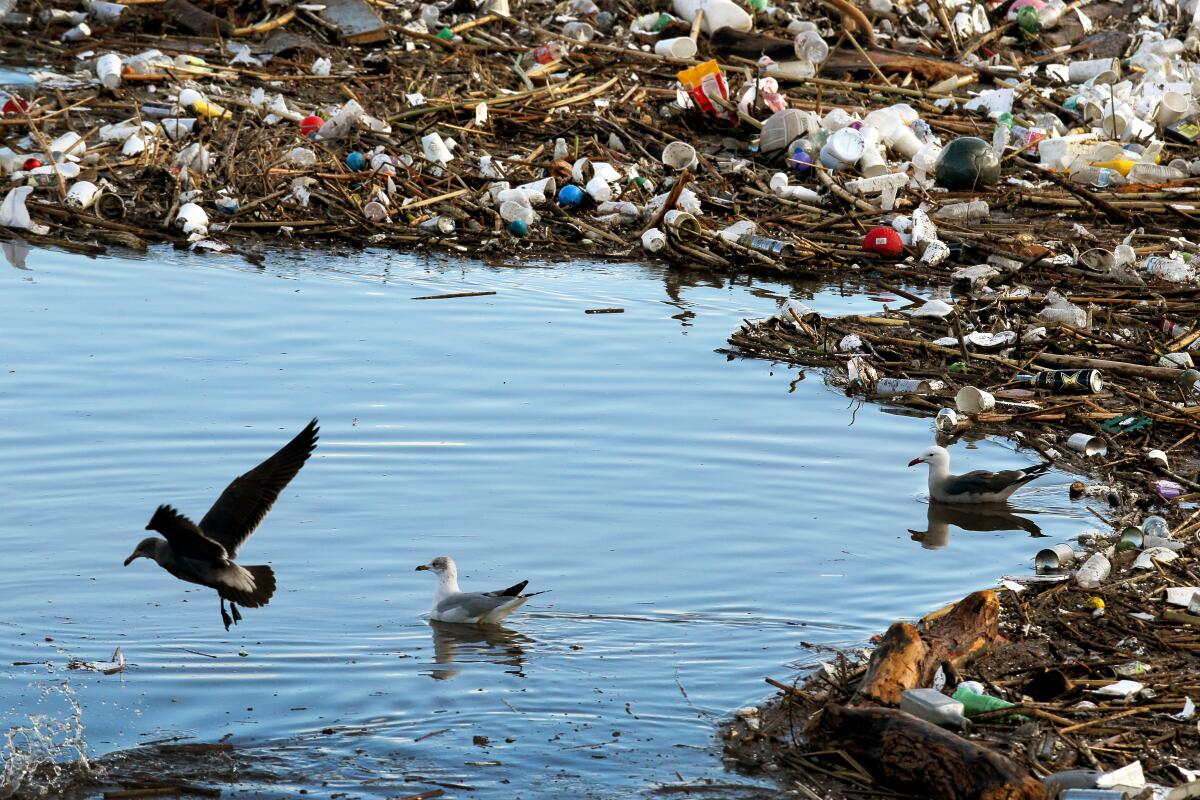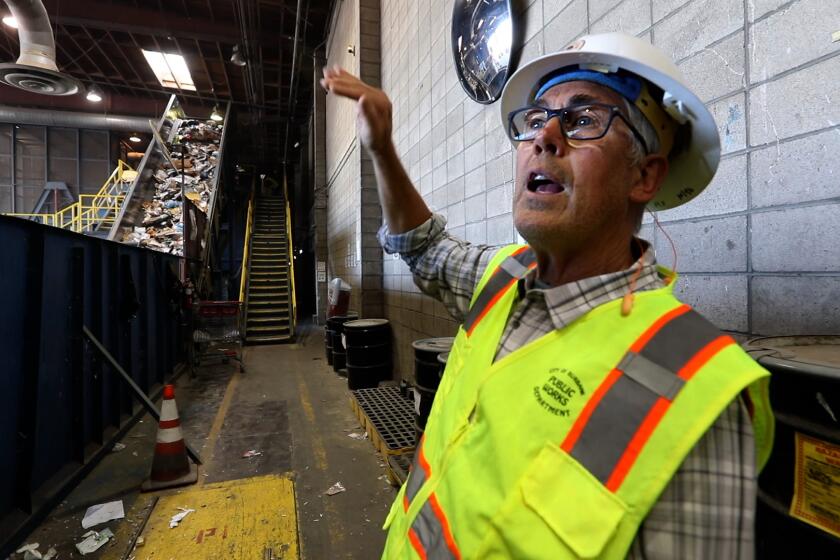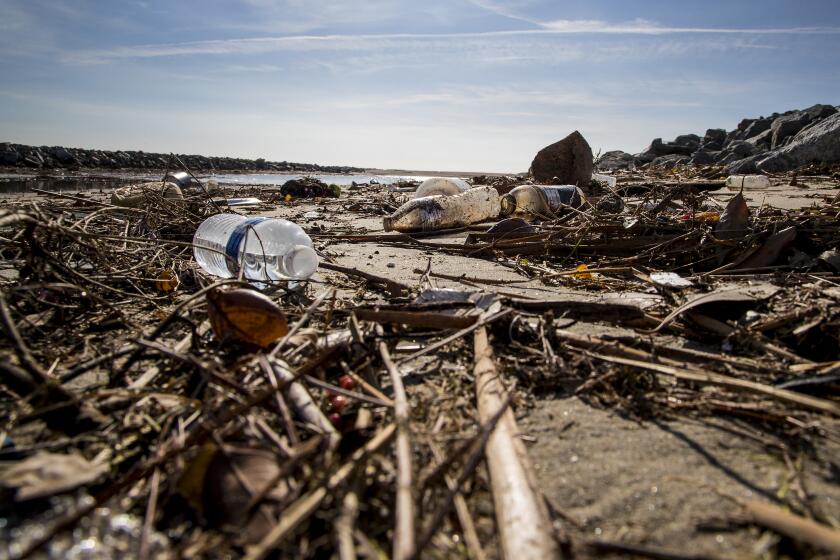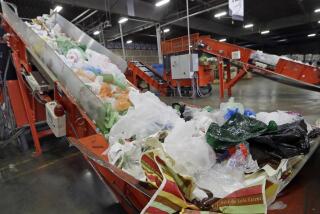Big fight brewing over California ballot measure to reduce single-use plastics

- Share via
SAN JOSE — On any given afternoon, the garbage cans in San Jose’s Westfield Oakridge Mall food court overflow with plastic spoons, forks, soft drink cups and takeout food containers. Paper frozen yogurt containers are mashed in with plastic boba tea cups and soda bottles.
The same can be seen across California — piles of single-use plastics that can’t easily be recycled, pollute roadsides and waterways and add to the garbage that clogs landfills.
In November, Californians may get a chance to shrink that waste. An initiative designed to reduce single-use plastics and polystyrene food containers will be on the ballot, a move by environmentalists to bypass the Legislature, where such measures have repeatedly failed in the face of industry lobbying.
“Honestly, the thinking driving this ballot measure is to get the attention of industry in a way that we haven’t been able to get in the Legislature,” said Jay Ziegler, director of policy and external affairs for the Nature Conservancy in California, a proponent of the measure. “And while we’ve achieved incremental reforms in labeling and process in respect to plastics, we really haven’t tackled the reality that we are drowning in plastics.”
The initiative — known as the California Recycling and Plastic Pollution Reduction Act — would require all single-use plastic packaging and food ware used in California to be recyclable, reusable, refillable or compostable by 2030, and single-use plastic production to be reduced by 25% by 2030.
It’s similar to an ordinance given preliminary approval last week by the Los Angeles County Board of Supervisors, taking aim at single-use plastics and polystyrene in food service.
Currently, 85% of single-use plastics are not recycled, and single-use plastics make up 50% of plastic waste.
California’s recycling industry has struggled since China banned imports of plastics and other material. Experts say changes are vital to overcome a waste glut.
The proposed law would also require that producers reduce or get rid of any single-use plastic packaging or food ware that CalRecycle determines is unnecessary for that product or food item’s delivery, and it would prohibit food vendors from distributing polystyrene food containers.
“The problem is so overwhelming and massive at this point that we need a serious, comprehensive policy that addresses this at the source,” said Linda Escalante, Southern California legislative director for the Natural Resources Defense Council and one of the measure’s three official backers. The initiative “cuts the amount of plastic that gets in the system to begin with and makes it easier to manage the materials that get into that system.”
A new poll from the environmental organization Oceana shows that 86% of California voters support government policies to reduce single-use plastic, while 91% say they are concerned about plastic pollution and its impact on the environment and our oceans. An additional 72% support policies that specifically reduce the use of plastic packaging from online shopping, and around 60% say they’d pay more for items that didn’t contain single-use plastics.
That poll aligns with surveys taken by the Public Policy Institute of California and others between 2019 and 2021 that show roughly two-thirds of Californians support legislation and are concerned about plastic pollution.
Businesses and trade groups that produce or distribute single-use plastic items, however, are overwhelmingly opposed.
“The way the law is written gives unfettered authority to CalRecycle to tax other recyclable products including glass, cardboard, et cetera to meet the goals of the ballot measure,” said Michael Bustamante, spokesman for the “No on Plastics Tax” campaign. The coalition includes the California Business Roundtable, the California Retailers Assn. and the California Chamber of Commerce.
He provided a partial list of 61 items, including Easter candies, Christmas lights and frozen shrimp, that would be subject to the less-than-1-cent fee. At most, shoppers would pay an extra $0.61 for filling their shopping cart with all of the items.
Joshua Baca, vice president of plastics at the American Chemistry Council, said his trade organization — which represents plastics producers, chemical manufacturers and fossil fuel companies — also has concerns about the measure’s cost on taxpayers.
His group and the Roundtable estimate the initiative would cost producers and distributors $4.28 million each year. And it would increase the costs to households by $900 a year.
“The ballot measure to tax plastics is a regressive tax that will raise costs on working families and businesses least able to afford it,” he said in a statement.
Robert Lapsley, president of the California Business Roundtable, agreed, adding that his organization supports the goal of reducing plastic waste. But “now is not the time” for this initiative, he said, as Californians are struggling with rising inflation and astronomical gas prices.
Environmentalists say industry groups are exaggerating the potential price tag while minimizing the costs their throwaway products impose.
Nick Lapis, director of advocacy for Californians Against Waste, said that “taxpayers have borne the cost of plastic waste management for years” — via garbage service, water protection and litter removal. In addition, he said, the less-than-1-cent charge per item is smaller than the 5-cent tax now applied to plastic bottles.
“The lobbying arm of the plastics and chemical industry is admitting to producing and distributing in California more than 428 billion items of plastic packaging,” said Mark Murray, executive director Californians Against Waste. “We can’t continue this level of non-recyclable, non-biodegradable pollution.”
Eric Potashner, former vice president at the Bay Area’s primary waste management company, Recology, added that the tax would not fall on consumers but the producers and distributors of plastics. These businesses, he noted, could avoid the costs completely by using compostable or recyclable materials.
Revenue generated from the tax — potentially billions of dollars annually, according to the Legislative Analyst’s Office — will be used to fund programs to implement and enforce the measure, for statewide and local recycling, reduction and composting efforts, and for habitat restoration and plastic pollution mitigation.
The initiative was conceived in 2018 when Michael Sangiacomo, former president of Recology, saw a “60 Minutes” episode about the huge swath of the Pacific Ocean that was covered in plastic. Recology was favorably featured in the segment as a leader in waste reduction and recycling.
According to Potashner, who was instrumental in the company’s push for the measure alongside Sangiacomo, the president of Recology felt they still weren’t doing enough. So Sangiacomo penned a letter pledging to do more and backed it up with $1 million.
The letter set off a movement. And after two years of a pandemic, a series of legal challenges and an additional $3 million from Recology, the initiative is now set to appear on ballots in November.
The only exception would be if legislators — by the end of June — are able to craft a law that proponents of the measure deem acceptable. If that happens, the proponents — Escalante, Sangiacomo and Caryl Hart, vice chair of the California Coastal Commission — could remove the initiative.
And it’s here in the crafting of legislation that industry groups are hoping to have influence.
The legislative clock runs out on two California bills seeking to phase out single-use plastic containers and ease the state’s recycling crisis.
Baca, the chemistry council’s spokesman, said that Senate Bill 54 — introduced by state Sen. Ben Allen (D-Santa Monica) — “is a better solution.” He encouraged lawmakers to expedite this legislation “and oppose the costly ballot measure.”
For his part, Allen is hopeful the legislation will finally pass, having gone down to defeat in 2019 and 2020. He said “very serious people” are negotiating and seem determined to resolve outstanding issues.
Jennifer Fearing, a lobbyist for several ocean protection organizations, said the bill, once ironed out, “will likely be vastly more comprehensive than the initiative,” reducing uncertainty about how the law will be implemented.
“When you write something for the ballot, you can’t get into every detail,” said Fearing, who has been working to negotiate a bill that could pass and be signed by the governor by the end of June.
“It should shame the Legislature that this issue is having to be tackled by the voters,” she said. “The people should not have to be deciding this.”
The Nature Conservancy’s Ziegler and others say it is imperative the state act now. In just the last few months, research has shown the presence of plastic particles in human blood, healthy lung tissue and meconium — the first bowel movement of a newborn. It is also in marine organisms, ocean water, air and soil.
Researchers project that by 2050, the mass of plastic pollution in the ocean will exceed the mass of fish. In addition, the latest report by the Intergovernmental Panel on Climate Change details how plastic contributes to the warming of the atmosphere.
“The new IPCC report underscores that by 2030, plastic pollution and handling of waste will account for 50 million metric tons of carbon production, exceeding the footprint of coal in producing atmospheric carbon,” Ziegler said. “We’re on a trajectory that is unsustainable.”









